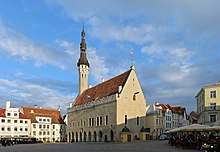Tallinn City Hall
Coordinates: 59 ° 26 ′ 13.5 " N , 24 ° 44 ′ 43.7" E
The Tallinn City Hall ( Estonian Tallinna raekoda ) is one of the landmarks of the Estonian capital Tallinn . It forms the center of the old town, which is a UNESCO World Heritage Site .
history
The location and appearance of the first Tallinn Town Hall can only be guessed at. A city council had existed since the 13th century. The existence of a town hall (consistorium) was first mentioned in documents in 1322. The town hall was built between 1402 and 1404 in its current location and in its present form. It is the only preserved town hall in Gothic style in Northern Europe. Tallinn City Council ran the city from there until 1970, before moving into a modern building.
description
The massive, two-storey building is still completely committed to the late Gothic style of the Middle Ages . The main facade on Rathausplatz is crowned by a crenellated wreath . Two gargoyles in the shape of dragon heads are attached to it. The work from 1627 comes from the coppersmith Daniel Pöppel .
There is a slender, octagonal tower on the east side. Its peak was in 1628, a spire in the style of late Renaissance placed. Tallinn's most famous weather vane , the " Old Thomas " (Vana Toomas) , has been on the top of the tower since 1530 . The figure, which used to be gilded, depicts a mercenary holding a flag in his hand. In the 64 m high tower is one of the oldest bells in the Baltic States , which used to serve as a fire alarm for the city.
The ground floor of the town hall is dominated by an eight-bay archway that opens onto the town hall square. It offered protection from rain or snow, but in the history of the town hall it also housed stalls and shops. Behind the archway were the building's storage and cellar rooms as well as the city council's wine store.
inside rooms
The upper floor contained the actual representation and meeting rooms of the town hall. An entrance on the right side of the building leads to the two-aisled Citizens' Hall (also called “Vorhaus”) on a stone staircase. The vaults rest on slender octagonal columns. They are brightly painted with a herringbone pattern. The historical tapestries that came to Tallinn from Flanders in 1548 are now in the City Museum. Two of them show scenes from the life of King Solomon .
A door leads from the Citizens' Hall to the Council Hall, the historic meeting room of Tallinn City Council. Until the end of the Hanseatic League, he decided according to Luebian law . The preserved medieval council stalls take up themes from medieval literature and Christian symbolism in its carving. On the side of one of the council chairs is the depiction of Tristan and Isolde , which was made around 1370. Furthermore, Samson's fight with the lion as well as Samson and Delilah are shown. Below is a picture of Aristotle with the hetaera Phyllis , which was created around 1435.
During the renovation in the 17th century, eight lunette pictures with text legends on biblical topics were attached, which the Lübeck painter Johann Aken had made in 1667. There was also a baroque frieze with hunting scenes by the well-known Tallinn art carver Elert Thiele (1665/1667) as well as floral and ornamental motifs from the carving workshop of Joachim Armbrust (1696).
Town Hall Square
The Town Hall Square (Raekoja plats) is still the lively center of Tallinn's old town, the so-called "Lower Town". Already in the Middle Ages it was a market place and a place for large celebrations such as the processions of the merchant brotherhoods, weapon games as well as carnival and May celebrations. The pillory of the city also stood on the Rathausplatz . A wooden figure by the master carver Elert Thiele was erected here in 1664. From a certain point on Town Hall Square, all five of Tallinn's main churches can be seen.
The Tallinn Council Pharmacy from the 15th century, one of the oldest pharmacies in Europe, is located directly opposite the Town Hall . Other historical buildings testify to the medieval prosperity of Tallinn, which had already joined the Hanseatic League in 1284 .
gallery
Cross in the foreground and Old Thomas in the background
literature
- Eugen von Nottbeck, Wilhelm Neumann: History and art monuments of the city of Reval. Volume two: The city's art monuments. Tallinn 1904. pp. 186-198
Web links
Individual evidence
- ↑ Tiiu Viirand (ed.): Estonia. Cultural Tourism. Tallinn 2004 ( ISBN 9949-407-18-4 ), p. 33
- ↑ The tower helmet was destroyed in the devastating Soviet air raid on Tallinn in 1944, but was reconstructed again in 1952.
- ^ Thea Karin: Estonia. Cultural and scenic diversity in a historical borderland between east and west. Cologne 1994 (= DuMont art and landscape guide ) ISBN 3-7701-2614-9 , p. 64f.











